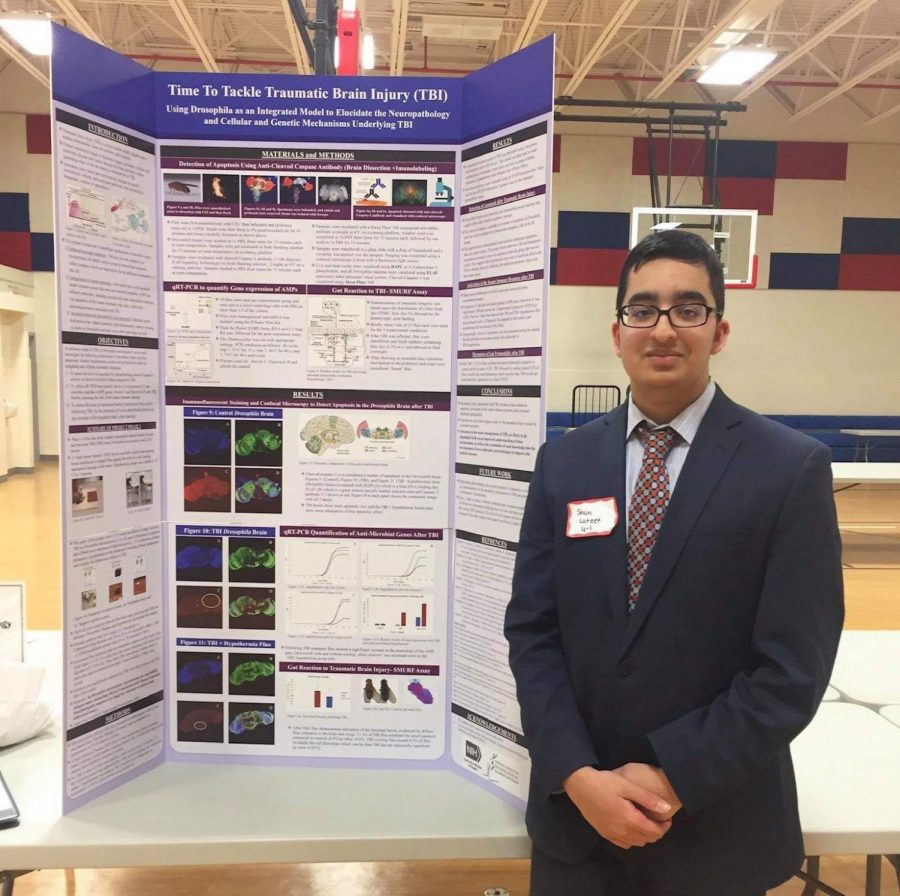Treating Trauma
Sophomore Shan Lateef’s Efforts to Test a New Treatment for Traumatic Brain Injury
February 23, 2019
Concussing fruit flies. Lowering their body temperatures. To an uninformed observer, sophomore Shan Lateef’s daily after school activities may seem like the work of a mad scientist, yet Lateef is far from one. Each concussed fruit fly is a crucial part of his groundbreaking research in Jefferson’s JUMP lab, where Lateef is currently testing an innovative method to treat traumatic brain injuries (TBIs).
Lateef’s drive to solve life-threatening brain diseases didn’t start when he came to TJ, however.
“I think it started at the end of seventh grade, and towards eighth grade, I just kept reading news articles about public health issues that are coming up, as well as neurodegenerative diseases that are not currently being treated. So I got interested in that. And I’ve always had an interest since elementary school about the brain in general,” Lateef said.
As the years continued, Lateef’s research became more and more advanced, and in eighth grade, Lateef studied the effect that UV radiation has on the common fruit fly . Upon coming to Jefferson, Lateef found out about the opportunity to conduct research in the JUMP lab, and driven by his interests in neuroscience and public health, Lateef applied with a proposal to test a novel treatment for TBIs.
“By the year 2020, traumatic brain injuries could become the leading international cause of morbidity and mortality, and we currently have no effective treatment strategy for concussions or repetitive concussions. So I wanted to see, could we develop an intervention strategy,” Lateef said. “That combined [not only] my passion for neuroscience and the brain and its complexities, but also my passion for public health.”
In reading about the issue of TBIs, Lateef discovered a relatively untested treatment method known as therapeutic hypothermia, which involves lowering a patient’s body temperature in order to reduce tissue damage in the central nervous system. Intrigued, Lateef began testing the method on common fruit flies.
“I wanted to see, could [therapeutic hypothermia] help the fruit flies battle against the concussion or the repetitive concussions. I have this device called a high impact trauma device, and essentially it’s a spring based mechanism where you have a vial of flies and you deflect the vial at 90 degrees, and then you let it go, and then the flies are supposed to get a mild to severe traumatic brain injury,” Lateef said. “So after that, I would cool the flies and then see after that, would behavioral responses be negative, and would they be mitigated by the addition of the therapeutic hypothermia treatment.”
After conducting tests for several months, Lateef concluded that therapeutic hypothermia was indeed effective in treating TBI, and showcased his results at the TJHSST science fair as well as regionals, where he won first place for his work. Yet, Lateef wasn’t quite done.
“I was encouraged by one of my mentors to publish in a journal. Now initially, I was like, ‘Well, I don’t know if that’s possible. I’m only a student, is that really feasible to do at this age,” Lateef said.
Despite finding the odds of being published stacked against him, Lateef began work on a research paper for his project and continued work on the paper through the summer. Although it was a tall effort, Lateef found the learning gap to be relatively small due to the skills he learned as part of IBET freshman year and the assistance given by mentors Aubrie Holman, Lateef’s biology teacher, as well Dr. Jennifer James, who works in the JUMP lab. Eventually, Lateef received word that his paper had been accepted by the Journal of Experimental Neuroscience.
“I won first place at the regional [science fair] but I guess that wasn’t the most important part of the whole thing. It was really the publication, because that validates my work in the JUMP lab with Dr. James and with Ms. Holman. And that’s the most rewarding, even for any scientist. To be published in a peer reviewed journal is the biggest honor anyone can receive,” Lateef said.
Today, Lateef continues to extend his research on traumatic brain injury in the JUMP lab as he delves further into the cellular and molecular processes affected by TBI.
“I really wanted to understand what is happening on the inside of the brain, what cellular and molecular processes are happening within the brain, and what further inflammatory processes are occurring,” Lateef said. “So three things that I looked at this year [were] apoptosis, intestinal barrier dysfunction, and if traumatic brain injury or repetitive traumatic brain injuries can actually cause the permeability of your gut to increase, allowing harmful bacteria into your stomach and other cells.”
Although Lateef notes the impact that freshman biology had on his ability to conduct the research published in the Journal of Experimental Neuroscience, he was simply lacking knowledge of a number techniques needed to take a deeper look into therapeutic hypothermia’s effect in treating TBI. As a result, Lateef chose to enroll in DNA Science 1 and 2 this year as opposed to taking AP Biology, the recommended course.
“I didn’t really look at it as a risk, because the grade is not the biggest thing in the world. It’s really what you learned, the knowledge you gained, and that was how I looked at it. I looked at it from a perspective that I’m going to learn a lot of techniques that I would need to know in order for me to accomplish the research that I wanted to do,” Lateef said. “So I did not [feel that it was a risk] and I got a lot of feedback saying, ‘Oh, why are you doing it? You might not get an A.’ That’s not the main thing. That’s not important to me.”
As Lateef continues to receive recognition for his work — just this week, he was announced as one of four high school recipients of the American Academy of Neurology’s Neuroscience Research prize — he notes the impact that publication had on his motivation as well as passion for neuroscience research.
“I learned a lot about how the peer review process works in the real world and I would definitely recommend people, even if you don’t think you’re [going to] get published, just at least apply for it. That way, you get feedback on your project, because I got a lot of feedback on our project,” Lateef said. “And I definitely think all TJ students, if they’re [going to] do research, should consider just undergoing the publication process and seeing what they may need to improve on in the future.”






